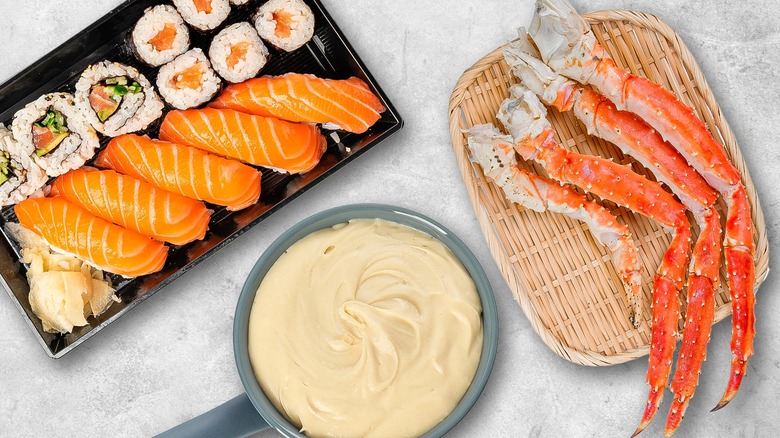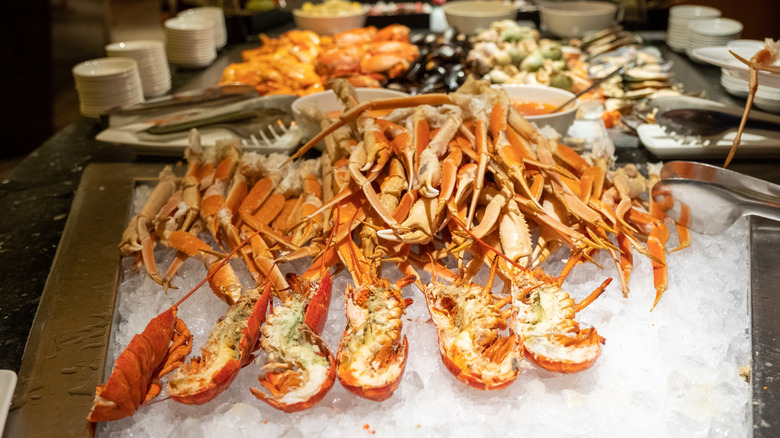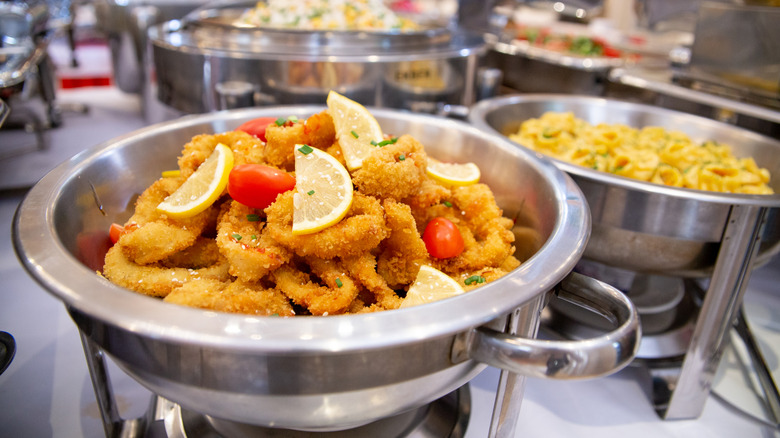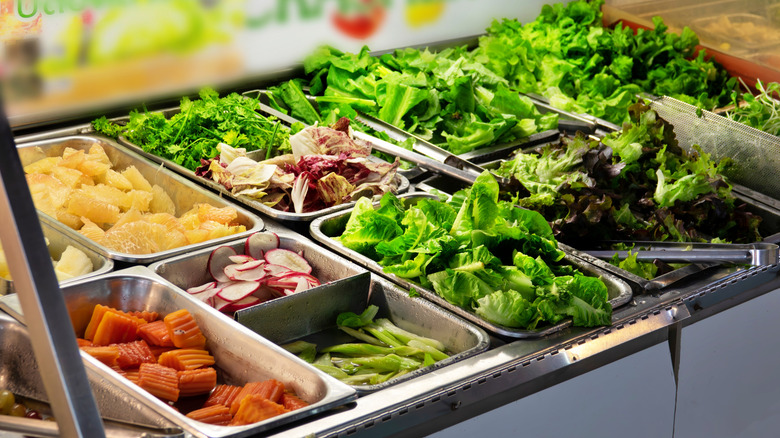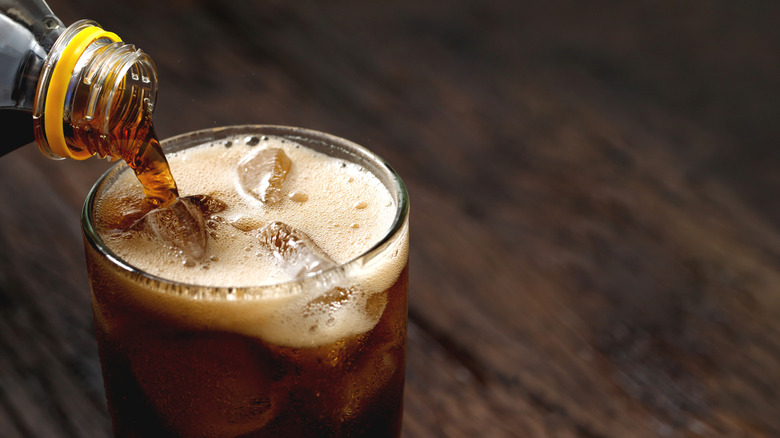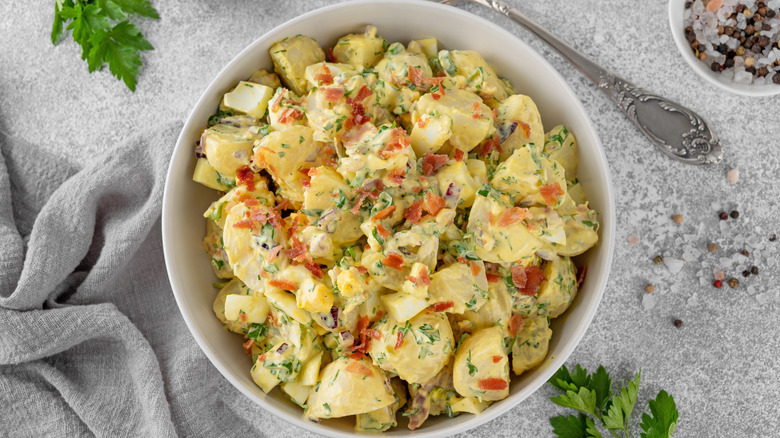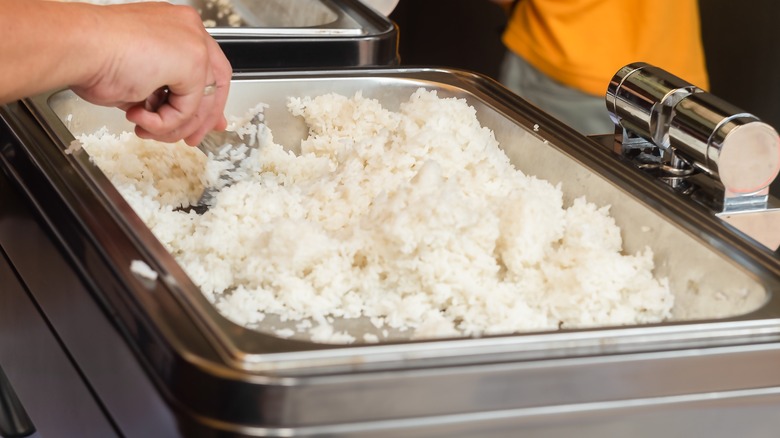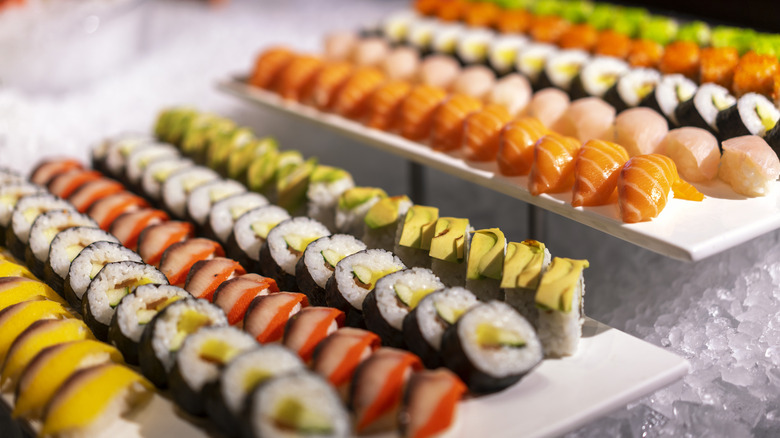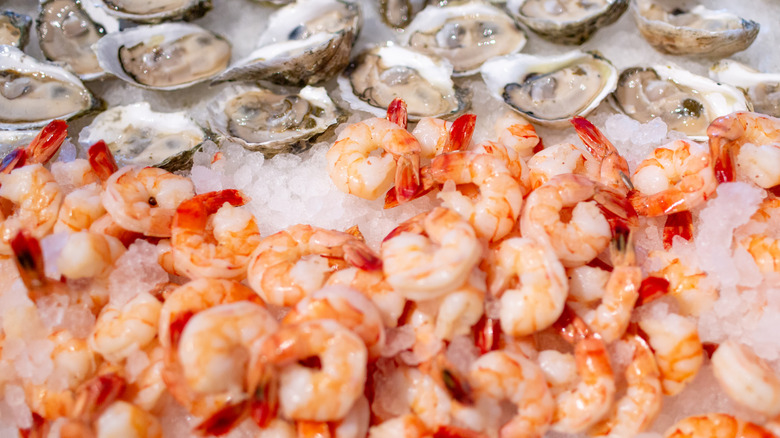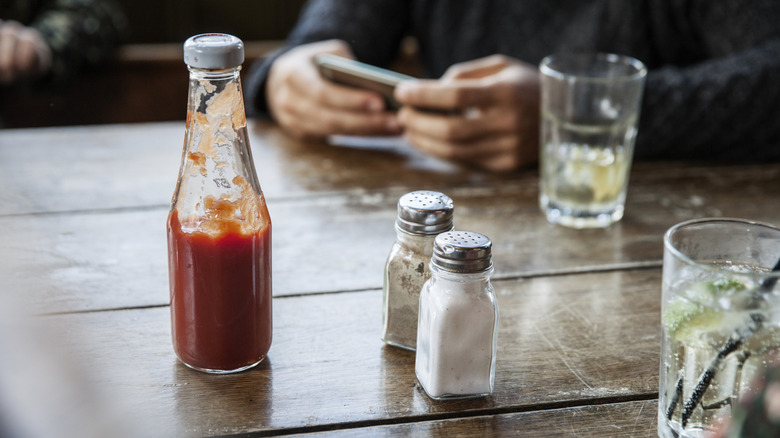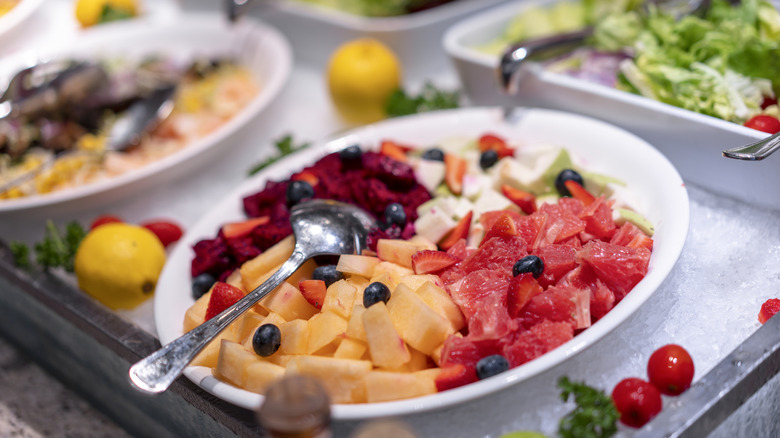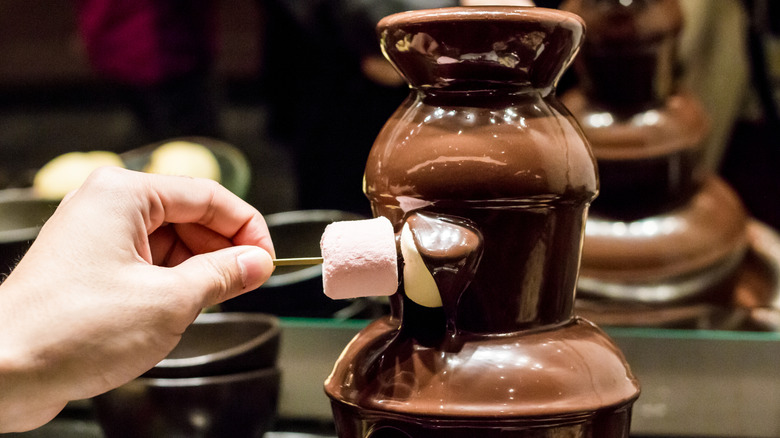13 Foods You Should Steer Clear Of When At A Buffet
Buffets are a wonderland for those with big appetites and picky palates. You have a plethora of entrées, drinks, snacks, and desserts to choose from, and you can make as many rounds as you'd like. But have you ever wondered exactly how establishments are able to offer this much food and often for a reasonable price? Well, to answer that, you'd have to learn some of the all-you-can-eat buffet secrets you probably never wanted to know. These will reveal that many restaurants prioritize quantity over quality, therefore there are several foods better left untouched on the buffet line.
Of course, you should get your money's worth, too, when dining out at a buffet. Just because everything is up for grabs at an all-you-can-eat establishment doesn't mean you should necessarily take advantage of each item, though. You can certainly load up on dishes that are safer to consume and higher in quality rather than choosing unnecessarily filling foods or those that can even put you at risk of food poisoning. That's why we've compiled a list of common buffet food options you may want to avoid.
1. Crab legs
The first item on the list might come as a big shocker to avid buffet-goers. Crab legs often seem like the biggest steal at an all-you-can-eat establishment, as evident by the many customers who stand like vultures waiting for the seafood tray to be replenished. Grabbing as many crab legs as possible is a priority for some people, and rightfully so if the eatery you're at is a high-quality one that you can trust. But there's always a chance that it's not.
An owner of a buffet took to Reddit to openly discuss whatever other users wanted to know about all-you-can-eat joints. To the dismay of many people, one of the facts shared by poster @buffetfoodthrowaway was the shadiness of crab legs. They said they had "seen Chinese buffets at the fish market going and buying bottom of the barrel seafood including crab legs past their prime. And then they don't steam them properly either to save on volume."
Improperly steaming crab legs has several downsides that can affect the quality of the seafood and your health. If they are overcooked, you'll be left with a tougher, rubbery meal that isn't as flavorful as it could be. And if they are undercooked, you are even worse off because you'll be at risk of food poisoning.
2. Fried foods
When you step foot into a buffet, chances are there's going to be a section dedicated just to fried foods. There you'll usually find an all-American lineup of fried favorites, from french fries, onion rings, and chicken nuggets to mozzarella sticks and chicken wings. These understandably serve as comfort food for many, but with the amount of time they've likely been left sitting out at the restaurant, eating them may be less soothing of an experience than you thought.
Amie Alexander, a registered dietitian at Nutri Peak, noted how fried foods can lose their appeal quickly. After being on display for quite some time, they can turn soggy and stale. Alexander says this means "the oil is oxidizing ... which gives an unpleasant flavor." It's also no secret that fried foods carry little nutritional value. They're extremely high in calories compared to grilled or baked foods and have more trans fat due to being cooked in oil at such high temperatures. For these reasons, it may be best to steer clear of them at a buffet.
3. Salad
It may seem absurd to find salad on this list of no-no's. Does it offer more nutrition than most of the things discussed? Absolutely. Is it any safer to consume at a buffet? Not exactly. There are many questionable options in the salad bar that can harbor bacteria and spoil quickly, starting with leafy uncooked greens and vegetables that make up a bulk of the meal.
Lettuce and spinach, for example, are already prone to E.coli. Their likelihood of being contaminated with the bacteria increases even more if they aren't kept over ice or at a temperature that's cool enough. Anywhere between 41 degrees Fahrenheit and 135 degrees Fahrenheit is considered the "danger zone" and will alter the safety of your greens and other raw veggies.
Even protein can be a source of food poisoning. Foods like meat, poultry, eggs, and dairy have a high moisture content and either a slightly acidic or neutral pH level, which allows bacteria to thrive if they aren't kept at the right temperature. Cross-contamination between animal protein and nearby ingredients will also render those foods more susceptible to harmful pathogens.
4. Soda
For the several plates of food you'll be going through at a buffet, it's important to have a beverage to wash it all down. It's pretty safe to say that many people's first choice is often a soda, as the revenue soft drinks have generated at bars and restaurants is more than $225 billion so far in 2024. No one can be blamed for wanting a refreshing drink to accompany their meal, but there are a couple of reasons not to get it that will outweigh the satisfaction of that crisp carbonation.
Perhaps the biggest reason not to order a soda at an all-you-can-eat restaurant is how filling it can be. Literally. When you drink something like Coke or Pepsi, the carbonation leads to a buildup of gas in your stomach. This expansion causes bloating and can make you feel full and with less of a desire to go back for more food. To avoid this, opt for water instead. It won't fill you up with startling amounts of gas and unnecessary sugar like most sodas will.
5. Creamy dishes
Cream-based foods make for some of the richest, most satisfying, and flavorful meals there are. But we hate to burst your smooth, buttery bubble — a buffet isn't usually the best place to enjoy these dishes. That's especially true if you're looking at something like a potato, tuna, or egg salad. Any other recipe that heavily uses mayonnaise falls within this category, too. These dishes "are highly perishable, especially when stored under inappropriate temperature conditions ... leading to Listeria and other pathogenic problems," according to Luke Seddon, a professional chef and the CEO of H2 Catering Equipment.
This would all be due to the common ingredient these dishes share: eggs. Cold egg dishes, such as the ones previously mentioned, must be kept on ice to maintain a temperature of at least 41 degrees Fahrenheit, while hot egg dishes must be maintained at 135 degrees Fahrenheit or above. Should the dishes fail to be kept at temperatures within these ranges, those who consume these egg-based foods can fall victim to bothersome symptoms like diarrhea, vomiting, headaches, and fevers.
6. Plain rice
Rice is a blank slate that pairs well with almost any entrée, especially with many of the ones offered at a buffet, such as General Tso's chicken or beef and broccoli. The caveat with rice is how rich it is in carbs. One cup of cooked white rice, for example, can have as much as 41.16 grams of carbohydrates. While carbs can be essential for providing energy and promoting digestive health, when you're at a buffet, view carb-filled rice as a filler food.
Grains of rice can expand up to three times their original volume, so it's no wonder people are left feeling full after eating it. Servings of rice also add up quickly since they're substantial in calories, which is why it's recommended to only eat half of a cup during your meal.
If possible, stick to a small portion of this starchy carb when you're eating at a buffet. Otherwise, you'll be too full to try anything else. If you must have rice, try to go for more unique or complex versions of it to make it worthwhile. Rather than plain white or brown rice, opt for fried rice instead.
7. Sushi
In a vast sea of options, sushi is often the prized possession found at a buffet. It's always a thrilling time walking in to see which variations the restaurant offers — from salmon rolls to shrimp tempura. As delicious as these Japanese delicacies are, though, where you purchase sushi can make a huge difference in its quality and safety.
The fish used within sushi is already a risk all on its own. Raw meat can contain bacteria, such as salmonella and parasites. The chance of your sushi containing these harmful microorganisms decreases if the location in which you're dining practices proper processing and handling. But an all-you-can-eat establishment may not be at the top of your list to ensure that. With the hustle and bustle that usually occurs in these types of eateries and with the many varied dishes to take care of, it's not guaranteed that buffet sushi is prepared and displayed in the best conditions.
Sushi needs to be sitting on a bed of ice to prevent the rapid growth of bacteria that occurs with lukewarm food. It's also important to take note of how long the sushi has been sitting out, which can be hard to gauge at a buffet. Raw sushi and sashimi can really only last up to two hours at room temperature. Past that, it's better to avoid them altogether.
8. Shellfish
Similar to sushi, Luke Seddon says shrimp and oysters can also pose a risk at buffets. "If they are left to sit and maintained at a temperature above room temperature, bacteria like vibrio and salmonella find favorable conditions to thrive and cause foodborne infections," the chef and CEO said. Vibrio is especially linked to raw oysters, which are commonly served at buffets despite the U.S. Food and Drug Administration advising that people thoroughly cook their seafood before consumption. This bacteria can cause mild symptoms like vomiting and diarrhea, while in more severe cases, it can lead to death.
It is for this reason that people with compromised immune systems should steer clear of shellfish at the buffet, especially when it's raw. Some people at risk include the elderly, those who have had recent stomach surgery, those taking medicine for stomach acid levels, and those who have had liver disease, among others. If you really have a hankering for some shellfish, though, try going for the ones that have been cooked properly before choosing raw options.
9. Shared condiments
Most people know it can be hard to enjoy french fries or nuggets without the flavor-enhancing goodness of a condiment. Whether it's tangy ketchup or smoky barbecue sauce, condiments can make a world of a difference in elevating what might be an otherwise mediocre meal. Buffets are well aware of that fact, which is why you'll often find some sort of condiment station within the restaurant.
Unfortunately, it's likely these stations aren't the cleanest. Many all-you-can-eat joints will have the condiments put out in open containers and there is always a possibility that a customer will accidentally spill a bit of one condiment into another. Or perhaps they use one utensil to scoop multiple condiments, and before you know it, you have a fusion of salad dressing and mustard. Another problem to consider is that employees might simply be topping off the condiments whenever they start to run low, leaving a pool of old sauce that has been out for quite some time at the bottom.
Even table condiments can carry more germs than you can imagine. It's not too difficult to picture a customer licking sauce or salt off their fingers right before cracking open that bottle of ketchup next to them. You'd be better off asking if the eatery has individual sauce packets available instead.
10. Pre-cut fruit
Fruit can serve as both an appetizer and a dessert for your all-you-can-eat experience. Bananas can stimulate your hunger with their high amount of natural sugars and carbohydrates while strawberries paired with chocolate cake can appease your sweet tooth. Fruits can even be used to get rid of your taste fatigue in between plates. But if you're going to pick up a fruit, you're better off picking one in its whole form, if it's an option.
If only pre-cut fruit is available, you'll want to proceed with caution as there's a big contamination risk with pre-cut fruit and veggies. Once these foods are peeled or sliced, they've lost that extra layer of protection and are now exposed to bacteria, which doubles rapidly every half an hour. Pre-sliced fruit is also further exposed to oxygen, heat, and light. This lessens their ability to retain vitamins in comparison to their whole counterparts and shortens their longevity overall. The bottom line is that a lot of the nutritional value you're seeking in your fruit could be outnumbered by the bacteria it grows once it's been cut up and left out for who knows how long.
11. Fondue
Everyone can appreciate the fun of a chocolate or cheese fondue fountain. A silky stream of melted cheese or liquid chocolate, ready to coat a variety of yummy goodies? What's not to love? The possibility of contamination, unfortunately. Fondue devices have a lot of nooks and crannies where the cheese, chocolate, and other foods getting dipped within it can get lodged. If all the machine's moving parts aren't cleaned properly after each use, it can be a breeding ground for germs and leftover food residue.
Another factor to consider is the sheer amount of customers that are using the fountain throughout the day. Who's to say people haven't accidentally (or intentionally) stuck their fingers in the flowing cheese or chocolate? It's also possible that people have dropped pieces of their food inside of it, and they're simply unseen. Whether it's a strawberry that slipped off the skewer or bread cubes that fell from their fondue forks, any ingredients left out long enough in the wrong conditions are prone to bacteria growth.
12. Lemon wedges
It's common to ask for a slice of lemon in your water or iced tea, as these citrus fruits add a refreshing, subtly sour taste to what otherwise might taste like a bland drink. Heck, some people even add lemon to their coffee for the same reason. Plus, lemons are known to offer a few health benefits, including providing extra vitamin C and aiding in digestion.
The problem with this fruit lies in its rind. This tough outer layer, and even the juicy, flavorful flesh of the lemons, can contain an abundance of germs. One study showed this to be true when 76 lemons were collected from 21 different restaurants, and after being swabbed, almost 70% of them were documented to produce microbial growth. This may come as a surprise considering lemons actually have antimicrobial properties. However, the study proved that it's still possible for microorganisms to form on them.
13. Things you can make at home
When you eat out, make sure you're taking advantage of all that's offered to you. That means prioritizing the dishes you wouldn't usually make yourself or buy elsewhere. After all, you left the house for a reason. Get your hands on the foods that aren't as easily accessible to you or able to be quickly conjured up from the comfort of your own kitchen.
For example, you can likely satisfy your craving for fast food french fries at a nearby McDonald's or Burger King for a much cheaper price rather than filling half your plate with them at the buffet. Or maybe your eyes meet the basic steamed white rice at the restaurant, but that's already what you typically pair with your entrées at home. It's better to avoid it altogether or to at least go for it in moderation. Get your money's worth at the buffet by loading up on new dishes instead.
